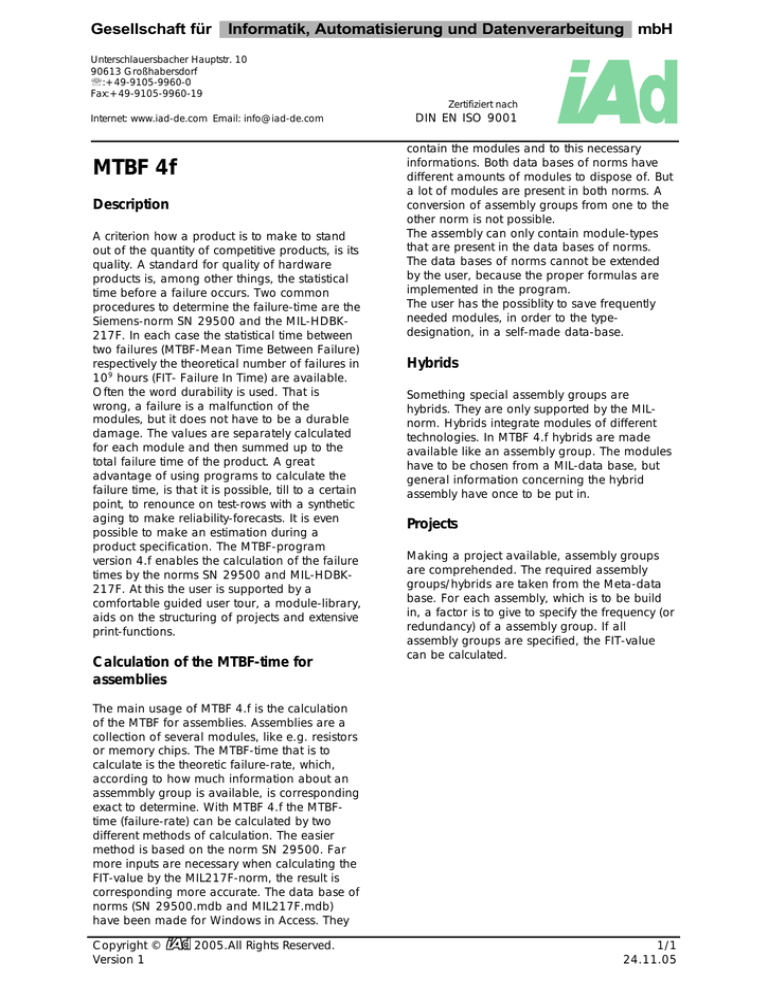
Gesellschaft für Informatik, Automatisierung und Datenverarbeitung mbH
Unterschlauersbacher Hauptstr. 10
90613 Großhabersdorf
':+49-9105-9960-0
Fax:+49-9105-9960-19
Internet: www.iad-de.com Email: info@iad-de.com
MTBF 4f
Description
A criterion how a product is to make to stand
out of the quantity of competitive products, is its
quality. A standard for quality of hardware
products is, among other things, the statistical
time before a failure occurs. Two common
procedures to determine the failure-time are the
Siemens-norm SN 29500 and the MIL-HDBK217F. In each case the statistical time between
two failures (MTBF-Mean Time Between Failure)
respectively the theoretical number of failures in
109 hours (FIT- Failure In Time) are available.
Often the word durability is used. That is
wrong, a failure is a malfunction of the
modules, but it does not have to be a durable
damage. The values are separately calculated
for each module and then summed up to the
total failure time of the product. A great
advantage of using programs to calculate the
failure time, is that it is possible, till to a certain
point, to renounce on test-rows with a synthetic
aging to make reliability-forecasts. It is even
possible to make an estimation during a
product specification. The MTBF-program
version 4.f enables the calculation of the failure
times by the norms SN 29500 and MIL-HDBK217F. At this the user is supported by a
comfortable guided user tour, a module-library,
aids on the structuring of projects and extensive
print-functions.
Calculation of the MTBF-time for
assemblies
Zertifiziert nach
DIN EN ISO 9001
contain the modules and to this necessary
informations. Both data bases of norms have
different amounts of modules to dispose of. But
a lot of modules are present in both norms. A
conversion of assembly groups from one to the
other norm is not possible.
The assembly can only contain module-types
that are present in the data bases of norms.
The data bases of norms cannot be extended
by the user, because the proper formulas are
implemented in the program.
The user has the possiblity to save frequently
needed modules, in order to the typedesignation, in a self-made data-base.
Hybrids
Something special assembly groups are
hybrids. They are only supported by the MILnorm. Hybrids integrate modules of different
technologies. In MTBF 4.f hybrids are made
available like an assembly group. The modules
have to be chosen from a MIL-data base, but
general information concerning the hybrid
assembly have once to be put in.
Projects
Making a project available, assembly groups
are comprehended. The required assembly
groups/hybrids are taken from the Meta-data
base. For each assembly, which is to be build
in, a factor is to give to specify the frequency (or
redundancy) of a assembly group. If all
assembly groups are specified, the FIT-value
can be calculated.
The main usage of MTBF 4.f is the calculation
of the MTBF for assemblies. Assemblies are a
collection of several modules, like e.g. resistors
or memory chips. The MTBF-time that is to
calculate is the theoretic failure-rate, which,
according to how much information about an
assemmbly group is available, is corresponding
exact to determine. With MTBF 4.f the MTBFtime (failure-rate) can be calculated by two
different methods of calculation. The easier
method is based on the norm SN 29500. Far
more inputs are necessary when calculating the
FIT-value by the MIL217F-norm, the result is
corresponding more accurate. The data base of
norms (SN 29500.mdb and MIL217F.mdb)
have been made for Windows in Access. They
Copyright ©
Version 1
2005.All Rights Reserved.
1/1
24.11.05


